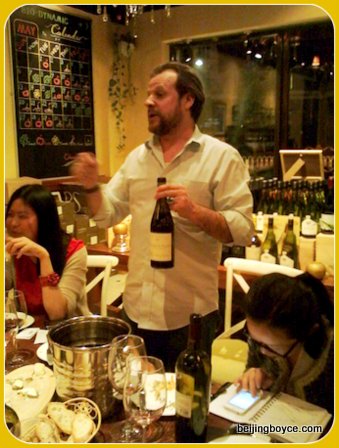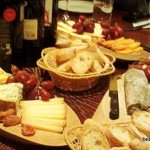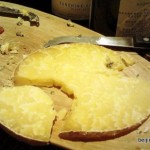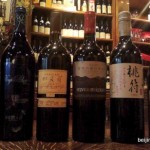By Jim Boyce
Two weeks ago, I dropped off my severely damaged computer at a repair shop near Chaoyang Park West Gate in Beijing and found my severely stressed self walking south. I spotted the shop Cheese & Wine, decided to visit, and within one hour — and aided by a few glasses of wine — made a plan with owner Christophe Pompeani to raid his walk-in ‘cellar’ of 40+ imported cheeses for a tasting. Funny how things work out. We held the tasting this week, with ten people gathering to try nine wines from China and nine cheeses from France.
One goal behind the tasting: to address a belief that milk and cheese have the same effect on lactose-intolerant people. The process of making cheeses tends to reduce lactose, especially with hard aged cheeses, and means many lactose-intolerant people can still enjoy them. (If you are lactose-intolerant, I suggest doing your own research on this topic.)
Another goal was to see how northwest China wines fare with quality French cheeses. These wines are made with locally grown grapes, as opposed to some wines that include imported bulk wine, and include some of the best brands the country. Some areas of north China, not to mention other parts of the country, also have long histories of consuming dairy products.
We gathered with three journalists, two sommeliers, one winemaker, one winery manager and one restaurant manager to experiment with the following:
Cheeses
Camembert au Calvados
Brie de Meaux
Ste Maure de Touraine (goat cheese)
Crottin de Chavignol (goat cheese)
Comte (aged 24 months)
Abbey de Belloc (ewe cheese)
Brique des Flandres
Reblochon
Stilton
Wines
Grace Premium Chardonnay 2009, Shanxi,
Grace ‘Tasya’s Reserve’ Chardonnay 2009, Shanxi,
Grace ‘Symphony’ Muscat 2009, Shanxi,
Sunshine Valley Pinot Noir 2009, Gansu,
Grace ‘Tao Fu’ Cabernet Sauvignon 2011, Shanxi,
Silver Heights ‘Family Reserve’ Bordeaux blend 2010, Ningxia,
Jia Bei Lan Dry Red Wine 2009, Ningxia
Grace ‘Deep Blue’ Bordeaux blend 2009, Shanxi
Tuoling Dry Red Wine, 2009 (I think), Xinjiang
We also had two French wines, Roger Sabon Cotes du Rhone (rmb195) and Camille Giroud Cote de Beaune Village 2002 (rmb495, on sale at rmb395), provided by Pompeani, and one Spanish wine, a bottle of Bosque De Matasnos Crianza 2009, provided by winery GM Jaime Postigo, who attended the tasting.
So, what did we find?
- That having 12 wines and nine cheeses meant 108 possible pairings — quite a lot for a “school” night. Luckily, we had Pompeani and others to suggest the most likely agreeable pairings.
- That using different categories of cheeses — hard, soft, goat, etc — helped as it allowed for strong contrasts. (I found the Calvados-washed Camembert especially interesting although I should note all of the cheeses were very good.)
- That the Chinese wines showed well. I think Fiona Sun of Revue du Vin first noted this. The more I thought about it, the more I agreed that most of the wines were more flavorful and balanced in this situation. Some were overwhelmed by the cheese, but on further tasting, they revealed delicacies I hadn’t noticed when trying them alone. Jia Bei Lan was at its best and drew appraisals such as “winter herbs”, “creme de mure”, “wild raspberries”, “almost like it has sun-dried fruit”. The Silver Heights ‘Family Reserve’ displayed a nice jamminess, while Grace ‘Deep Blue’ had a touch of smoke, both working with certain cheeses. The Tuoling, which I didn’t enjoy much in Xinjiang, was fruity and easy to drink in this context. The Grace ‘Tao Fu’ impressed as an accessible wine, one that might do well with food in general.
- That I found this more useful than pairing wine with “food”, that is, with a dish from a specific cuisine, when the taste can depend on the style of a given chef, available ingredients, and so on. There is something more simplistic — more primal — about pairing cheese and wine. It makes sense to me in a way that general food and wine pairing generally does not. But that could just be the Brie talking.
As for pairings, I asked Philip Ostenton, a sommelier and consultant in Beijing, for his top picks that night. They were:
- Jia Bei Lan with Stilton
- Grace Premier Chardonnay with Crottin de Chavignol (goat cheese). He thought a younger wine, even by one year and with more acidity, would have been even better.
- Sunshine Valley Pinot Noir with Abbey de Belloc (ewe cheese)
- Silver Heights and Brie de Meaux
Nicolas Carre, sommelier and wine teacher, said he liked the Grace Symphony Muscat with the Comte, since the saltiness of cheese paired well with the acidity of the wine, and the Silver Heights with both Brie and Camembert. Wine maker Li Demei, involved with Jia Bei Lan, also thought that wine paired very well with the Stilton. (Note: This was the Jia Bei Lan estate wine, not the reserve wine that won that Decanter award last year). I’ll add more reactions from attendees as I get them.
Overall, a good tasting, though I learned many things, should there be future endeavors. Things such as writing down the wine and cheese names so people don’t have to repeatedly ask how to spell them, having a more delineated wine lineup (we were heavy on Bordeaux blends), and so on. But for a first effort, organized on a chance encounter, I think it went well.
If this tasting sounds interesting, I suggest visiting Pompeani, grabbing a handful of cheeses, getting some wine, and holding your own sip and nibble. You can find Cheese & Wine beside Jenny Lou’s and Suzie Wong, near the West Gate of Chaoyang Park.
Note: Pompeani donated all of the cheese used in this tasting. As for the wines, Torres China / Everwines donated the Silver Heights, Grace ‘Deep Blue’ and Grace chardonnays, Globus donated the Sunshine Valley, and Judy Leissner of Grace Vineyard donated the ‘Tao Fu’. I bought the Grace ‘Symphony’, received the Jia Bei Lan a few months ago as a gift and got the Tuoling on a trip to Xinjing.)
Sign up for the Grape Wall newsletter here. Follow Grape Wall on LinkedIn, Instagram, Facebook and Twitter. And see my sibling sites World Marselan Day, World Baijiu Day and Beijing Boyce. Grape Wall has no advertisers, so if you find the content useful, please help cover the costs via PayPal, WeChat or Alipay. Contact Grape Wall via grapewallofchina (at) gmail.com.





Leave a Reply
You must be logged in to post a comment.